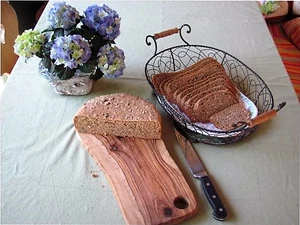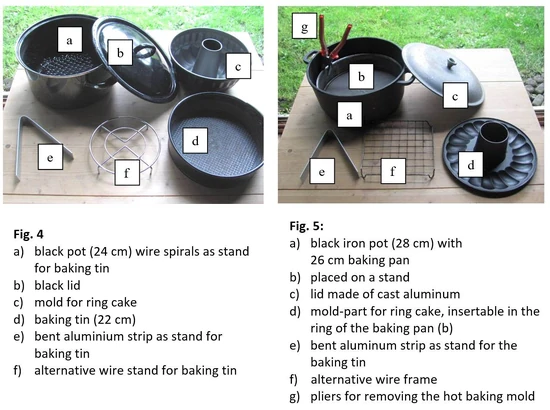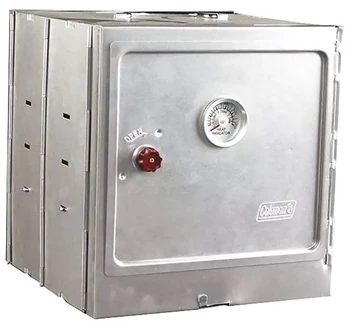|
Last edited: 21 June 2020
|
 Fig. 1: Bread baked in a parabolic solar cooker |  Fig. 2: Ring cake can be baked particularly well. |  Fig. 3: Croissants baked in a parabolic solar cooker |
Longtime solar cook Imma Seifert of Germany provided the information for this article showing how to bake in a parabolic solar cooker. Baking is a natural in solar box cookers or solar panel cookers, but can also be performed quite well in a parabolic solar cooker.
Guidelines[]
- To bake successfully, a baking tin is placed inside a larger pot. Do not put any water into the pot.
- Do not place the baking tin directly on the pot bottom, but on a stand (spacers), for example, a wire stand or a bent steel or aluminum strip (see Figures 4 and 5).
- The pot should not be unnecessarily high; otherwise the top of the bread will not brown. Close the pot with a well-fitting black lid. A glass lid acts like a burning-glass and can burn spots on the bread or cake. Baking has to be done with the lid of both the inner pot and the outer pot closed.
- I have found that a low black iron pot (28 cm diameter) with a baking tin of 26 cm diameter is perfectly suited for baking. I am using an alSol 1.4 solar cooker (parabolic mirror 1.4 m in diameter with mirror trapezes according SK-14 design). With a correspondingly smaller pot and a matching baking mold you can also bake with the smaller SK cookers.
- When baking, the pot is moved every 15 to 20 minutes a quarter turn so that the dough is browned on all sides evenly. Please use potholders when handling the pot!
- For bread and cake (26 cm diameter) the baking time is about an hour in bright sunshine. Biscuits can be baked in half an hour. The croissants shown in Figure 3 were baked in less than half an hour.
- The pot, the lid and the contents get very hot (up to 200 °C). When removing the hot baking pan from the outer pot, use potholders or even a pair of pliers (Fig. 5), and the baking mold can be reliably removed.
With solar cookers of SK-design the required baking temperatures,up to 200 °C (392 °F), are achieved with good solar radiation, but temperatures don't get hot enough to burn the baked goods if proper procedures are followed.
The baking tin with the dough is placed on a stand inside the outer pot, which then acts like a convection oven.
If the baking pan is placed directly on the pot base, the bread or the cake will be burnt on the bottom.
For baking in solar cookers clear sky is required. But if the sun is hidden for some time behind the clouds, this is no reason to give up. Let the pot in the solar cooker with the lid closed. It is important that the lid is not raised. When the sun reappears, you can continue the baking as usual.
Due to its suitability for baking, the solar cooker can serve as a source of income in cultures where baked goods are a luxury due to cooking only over a fire.
Documents[]
- NEW: Baking and preserving with the parabolic solar cooker (English, German) - Imma Seifert
Commercial campstove ovens[]

Insulated boxes that can be placed on a campstove (and presumably a campfire) are available for purchase. Amazon sells such ovens.
See also[]
External links[]
Contact[]
- See Imma Seifert.Imma Seifert



